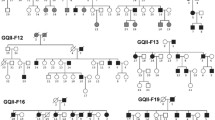Abstract
We analyzed two-locus disequilibria for 16 polymorphic loci of seven susceptibility genes for coronary artery disease located in five chromosomal regions distributed across four chromosomes. Included were the genes coding for apolipoprotein B (ApoB, chromosome 2, four marker loci), lipoprotein lipase (LPL, chromosome 8, three marker loci), apolipoproteins AI, CIII, AIV (ApoAI–CIII–AIV, chromosome 11, three marker loci), apolipoprotein E (ApoE, chromosome 19, two marker loci), and the low density lipoprotein receptor (LDLR, chromosome 19, four marker loci). Our sample included 540 unrelated individuals from the Rochester, Minn. population. There were no statistically significant deviations of single-locus genotypes from Hardy-Weinberg equilibrium. The strongest associations within genes were for composite diallelic disequilibria; 17/19 were significant (13 at Pr <0.001, 1 at Pr <0.01, 3 at Pr <0.05). These observations suggest marker alleles within genes have a shared evolutionary history reflected by disequilibria that have not been dissipated by recombination. Disequilibrium was not generally concordant with the physical orderings of markers. Only two significant higher-order disequilibria were observed although 12 triallelic disequilibria were at maximum possible values. We observed 19 statistically significant disequilibria (Pr <0.05; 4 composite diallelic, 13 triallelic, and 2 quadriallelic) between 101 pairs of marker loci, where each locus in a pair was from a different unlinked region. These unexpected results are most likely explained by recent historical factors, including worldwide population expansion and amalgamation with continuous admixture, that influence the genetic structure (organization of alleles and non-alleles into genotypes) of a population. We conclude that disequilibria between loci from unlinked regions may be more extensive than is commonly assumed. Our findings also suggest that it is, on average, at least 15 times more likely to not detect significant disequilibrium among unlinked loci when it is really present than to make a false positive inference. Disequilibria between functional loci within or between regions will impact estimates of genetic variance associated with particular functional mutations within a susceptibility gene region.
Similar content being viewed by others
Author information
Authors and Affiliations
Additional information
Received: 15 January 1998 / Accepted: 24 June 1998
Rights and permissions
About this article
Cite this article
Zerba, K., Ferrell, R. & Sing, C. Genetic structure of five susceptibility gene regions for coronary artery disease: disequilibria within and among regions. Hum Genet 103, 346–354 (1998). https://doi.org/10.1007/s004390050828
Published:
Issue Date:
DOI: https://doi.org/10.1007/s004390050828




